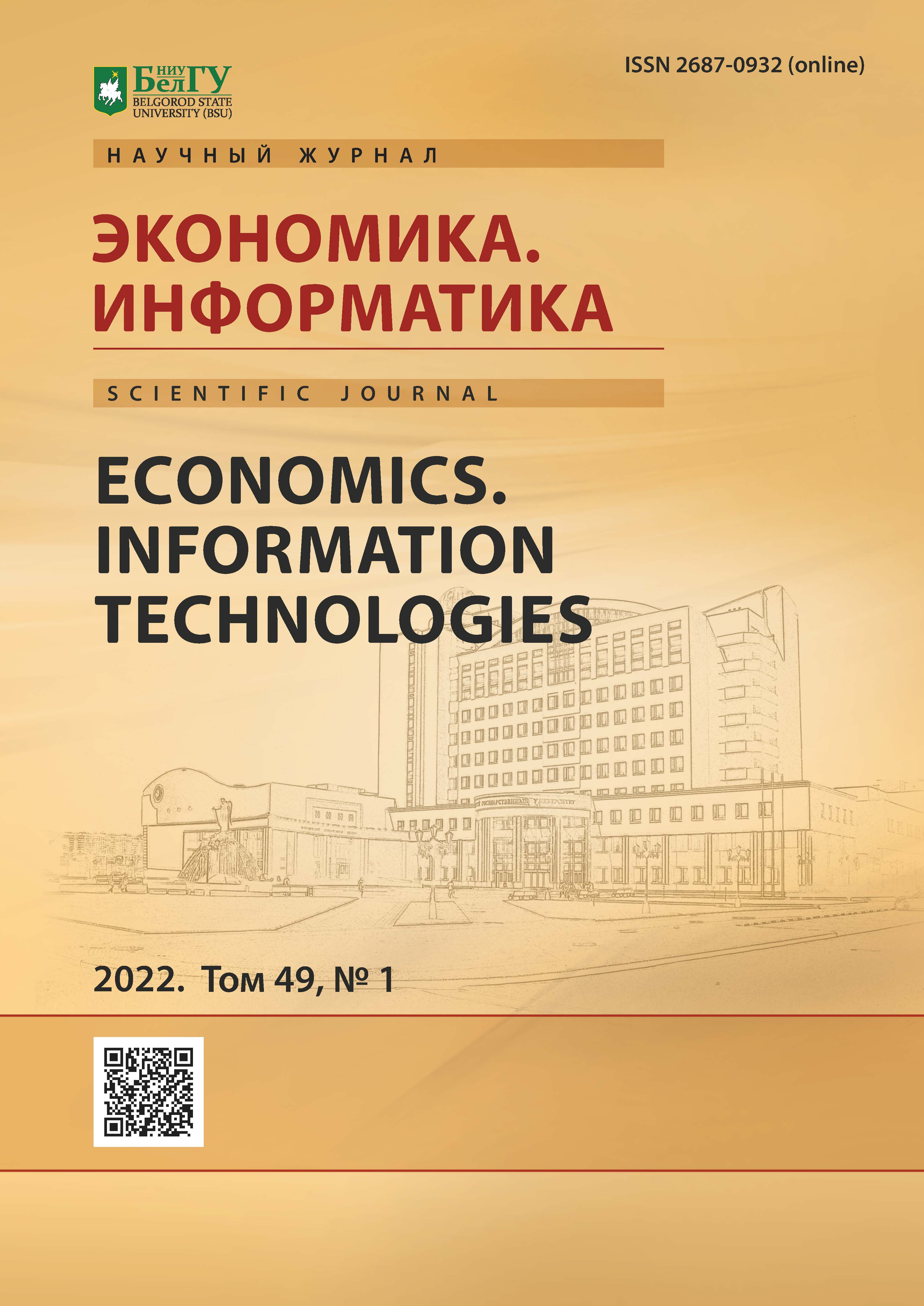Assessment of the spatial balance of Russia: regional aspect
DOI:
https://doi.org/10.52575/2687-0932-2022-49-1-17-30Keywords:
region, spatial balance, inequality, territorial development, economyAbstract
The distribution of productive forces in the spatial economy of Russia is unique: the regions of the Russian Federation are located within eleven time zones, the Russian Federation includes 85 subjects located in various natural and geographical conditions, there are no cities with a population of 2 to 5 million people, 85% cities have a population of less than 100 thousand people. Geographical individualities, climatic diversity and the consequences of the planned economy of the Soviet period determine the relevance of studying the features of the spatial imbalance of Russian cities and regions. The purpose of the article is to assess the spatial equilibrium in the regions of Russia. The scientific novelty of the research lies in the fact that the method for assessing the spatial balance is based on determining the potential of spatial proposals and the intensity of demand for development with the determination of the state of spatial equilibrium. Based on the results of the calculations, it was concluded that Moscow and the Moscow region have the maximum potential, since industrial, financial, labor, and scientific resources are concentrated on their territory. High values were obtained for oil-producing regions (Nenets, Khanty-Mansi and Yamalo-Nenets autonomous okrugs). The intensity of demand for development is widely differentiated: a high level is determined for Moscow and St. Petersburg, the remaining regions have a low level of this indicator. The balance of a high level (1.15 %) is present only in one subject - the city of Moscow. Overuse of potential (1.15%) is observed in St. Petersburg. A strong lag in development is characteristic of 6.9 % of the regions; lagging behind in the development of 18.39 % of regions; 72.41 % of Russian regions have a low balance. The practical significance of the study lies in the possibility of applying the results obtained by the authorities in terms of preparing regional strategies and programs for socio-economic development aimed at improving the quality of life of the population.
Acknowledgment: the study was supported by a grant from the Russian Foundation for Basic Research, project No. 19-010-00523.
Downloads
References
Регионы России. Социально-экономические показатели. 2020: Р32 Стат. сб. / Росстат. М., 2020. 1242 с.
Температура воздуха и осадки по месяцам и годам: http://www.pogodaiklimat.ru/ history.php (дата обращения 01.07.2021г.)
Александров И.Г. 1928. Производственное районирование и его методология. Плановое хозяйство, 4: 46–58.
Андреев В.В., Лукиянова В.Ю., Кадышев Е.Н. 2017. Анализ территориального распределения населения в субъектах Приволжского федерального округа с применением закона Ципфа и Гибрата. Прикладная эконометрика, 48: 97–121.
Анимица Е. Г., Анимица П. Е., Денисова О. Ю. 2014. Эволюция научных взглядов на теорию размещения производительных сил. Экономика региона, 2: 21–32.
Балаш О.С. 2013. Моделирование темпов роста численности населения городов России: пространственный аспект. Экономика, статистика и информатика. Вестник УМО, 6: 142–146.
Дворядкина Е.Б., Белоусова Е.А. 2020. Тенденции развития муниципальных районов в национальном экономическом пространстве, Экономические и социальные перемены: факты, тенденции, прогноз, 13 (1): С. 87–105.
Ибрагимова З.Ф., Франц М.В. 2020. Неравенство возможностей: роль пространственного фактора. Пространственная экономика, 16(4): 44–67. doi.org/10.14530/se.2020.4.044-067.
Коломак Е.А. 2018. Городская система современной России. Новосибирск: Издательство ИЭОПП СО РАН, 144 с.
Колосовский Н.Н. 1969. Теория экономического районирования. М.: Мысль, 1969. 335 с.
Макарова М.Н. 2021. Моделирование социально-демографической асимметрии территориального развития. Экономические и социальные перемены: факты, тенденции, прогноз. 14 (2): 29–42. DOI: 10.15838/esc.2021.2.74.2
Некрасов Н.Н. 1979. Региональная экономика: теория, проблемы, методы. 2 изд. М.: Экономика,
с.
Фейгин Я.Г. 1969. Ленин и социалистическое размещение производительных сил. М.: Наука, 115 с.
Jin R., Gong J.Y., Deng M., Wan Y.L., Yang X.Y. 2018. A framework for spatiotemporal analysis of regional economic agglomeration patterns. Sustainability, Электронный ресурс: https://www.mdpi.com/2071-1050/10/8/2800/ (Дата обращения 15.06.2021г.).
Combes P., Lafourcade M., Thisse J.F., Toutain J.C. 2011. The rise and fall of spatial inequalities in France: A long-run perspective. Explor. Econ. Hist., 48: pp. 243–271.
Badia-Miro M., Guilera J., Lains P. 2012. Regional incomes in Portugal: Industrialization, integration and inequality, 1890–1980., Economy, 30: 225–244.
Geary F., Stark, T.2016. What happened to regional inequality in Britain in the twentieth century? The Economic History Review, 69: 215–228.
Kim S.1998. Economic integration and convergence: US regions, 1840–1987. The Journal of Economic History, 58: 659–683.
Felice E. 2011. Regional value added in Italy (1891–2001) and the foundation of a long-term picture. The Economic History Review, 64: 929–950.
Cuadrado-Roura J., Aroca P.2013 Regional Problems and Policies in Latin America. Springer, 569 p.
Bluszcz A., Kijewska A. 2015. Challenges of sustainable development in the mining and metallurgy sector in Poland. Metalurgija, 54: 441–444.
Fan J., Li P.X. 2009.The scientific foundation of Major Function Oriented Zoning in China. Journal of Geographical Sciences, 19: 515–531.
Lu D.D., Fan J. 2010. Regional Development Research in China: A Roadmap to 2050. Springer, 192 p.
Zhuo Z., Chen W., Sun W. 2008. Study on framework of productive forces based on the theory of spatial balance – With Wuxi as a case, Areal Research and Development, 27 (1):19–27.
Hube M., Owen A. Cinderby S. 2007. Reconciling socio-economic and environmental data in a GIS context: An example from rural England. Applied Geography, 27: 1–13.
Ogneva-Himmelberger Y., Pearsall H., Rakshit R.2009. Concrete evidence & geographically weighted regression: A regional analysis of wealth and the land cover in Massachusetts. Applied Geography,
: 478–487.
Zhang Y.Z., Zhang J.L., Chen Y., Ren J.L. 2016. Study on the meaning of space balance and condition assessment from the perspective of supply and demand driven: A case of Shandong Province. Social Sciences, 30: 54–58.
Shen H., Teng F., Song J. 2018. Evaluation of Spatial Balance of China’s
Regional Development. Sustainability, Электронный ресурс: https://doi.org/10.3390/su10093314 (Дата обращения 15.06.2021г.).
Abstract views: 319
Share
Published
How to Cite
Issue
Section
Copyright (c) 2022 ECONOMICS. INFORMATION TECHNOLOGIES

This work is licensed under a Creative Commons Attribution 4.0 International License.


